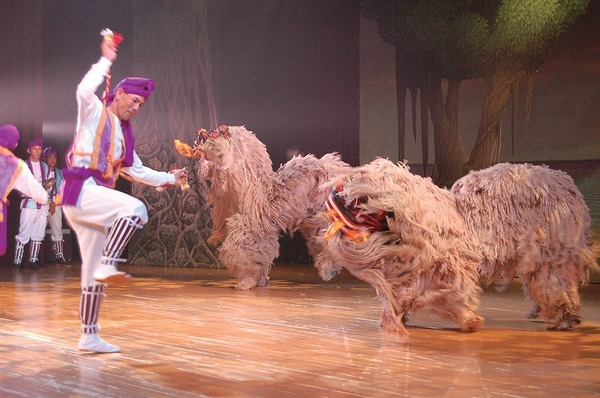トップ > 市の組織 > 教育委員会 > 生涯学習部 > 生涯学習振興課 > 【市指定:無形民俗】松原の獅子舞い:シーシャ
【市指定:無形民俗】松原の獅子舞い:シーシャ
〔まつばらのししまい:しーしゃ〕
毎年旧暦の5月4日に行われるハーリー(海神祭)の際、ズガキと称する海岸端の広場で海上安全、豊漁祈願および魔除けの行事として演じられている。海上での行事が終わると、舞台はズガキの広場の祝宴に移り、いよいよ獅子の登場となる。獅子は雄獅子と雌獅子の二頭獅子で、獅子舞いは獅子役と囃子役・三線の伴奏で構成される。
獅子役は、獅子頭(シーシャ)を操作する役と尻尾の部分をあやつる係の2人で囃子役(タースビー)はターサ(六尺)とツヅンフチャ(小太鼓役)各1人、三線は1~2人で行われる。
獅子役は、獅子頭の鼻の穴あるいは口の穴からターサの動きを見てそれに合わせて勇猛に獅子頭を動かし、尻尾の者も体をくねらせて呼応する。獅子の舞い方は即興的で、小太鼓の伴奏も素朴である。
宮古のハーリーで獅子舞いが演じられるのは久貝・松原集落だけである。中でも松原の獅子舞いは、組織的に古くから受け継がれてきており、人々の風俗・習慣を知る上からも貴重な無形の民俗文化財である。
【Designated by the City:Intangible Folk 】Shisha (Lion Dance) of Matsubara
This dance is performed at the square by the coast, referred to as Zugaki, during the Hari (Sea God Festival) held every year on May 4 of the lunar calendar. That dance is part of the event to pray for good catch at sea and to ward off evil spirits. Once ceremonies are complete at sea, the festivities move on to the Zugaki, and finally, the Shishi lions make their appearance. There are two Shishi lions, a male and a female, and the dance includes the lions, the singers/rhythm keepers and the Sanshin players.
The performance of the Shishi dance is conducted by a person who carries the head of the Shisi (Shisha), and a person who carries the tail-end. The rhythm of the dance is accompanied by the Tasa (flute) and Tsuzunfuchi (small drum) players as the Tasubi, and one or two Sanshin players for the music.
The Shisha watches the movements of the Tasa through the nostrils or the mouth of the lion’s head, dancing vigorously as the tail-end twists and turns to meet the moves. The dances of the lions are improvised and the accompanying drums are very simple.
Among the Hari festivities in Miyako, the only regions where the Shishi dance can be observed are in the Kugai and Matsubara settlements. The Shishi dance of Matsubara, in particular, is an organized performance handed down from ages ago, and it is a valuable, intangible folk culture asset to understand the customs and traditions of the people.
【市指定:無形民俗】松原的獅子舞
每年舊曆5月4日舉行賽龍舟(海神祭)的時候,在名叫茲伽基的海岸邊廣場表演獅子舞來祈禱海上安全、漁獲豐收以及進行除魔的儀式。海上的儀式結束後,舞臺轉移到茲伽基廣場的慶祝宴會,接著就是舞獅的登場。舞獅分雄獅和雌獅兩頭,獅子舞由舞獅者和戲獅者以及三弦琴的伴奏組成。
舞獅者分操縱獅頭和獅尾两人,戲獅者是手持六尺棒和小太鼓各1人,三弦琴通常由1~2人表演。
舞獅者從獅子頭的鼻孔或張開的嘴巴往外看六尺的動作,然後跟著節拍勇猛地舞動獅頭,操縱獅子尾巴的舞者也扭動著身體與之相呼應。獅子的舞動方法都是即興表演,小太鼓的伴奏也很簡單樸素。
在宮古的賽龍舟時,表演獅子舞的只有久貝和松原村落。其中,尤其以松原的獅子舞是有組織性地自古繼承下來,是瞭解世人的風俗、習慣之珍貴無形民俗文化財產。
【미야코지마시 지정:무형 민속】마쓰바라의 사자춤 (시샤)
매년 음력 5월 4일에 행하는 하리(바다신 축제) 때, 즈가키라고 불리는 해안 끝 광장에서 해상의 안전과 풍어를 기원하는 액막이 행사로써 진행되고 있다.
해상 행사가 끝나면 무대는 즈가키 광장 축하 연회장으로 옮겨지고, 이윽고 암수 두 마리의 사자가 등장한다.
사자춤은 사자 역할과 타악기, 현악기 반주로 구성된다. 사자 역할은 두 명이 맡는다. 사자 머리(시샤)를 조종하는 역할과 꼬리 부분을 조종하는 역할이다. 악기의 경우, 다스비, 다사, 쓰즌후차는 각각 한 명, 현악기인 산신은 한 두 명이 담당한다.
사자 역할은 사자의 콧구멍 또는 입에서 다사의 움직임을 보고 그것에 맞추어 용맹스럽게 사자 머리를 움직이는 것이다. 꼬리 부분을 담당한 이도 몸을 구부려 호응한다. 사자춤은 즉흥적이며 북의 반주도 소박하다.
미야코의 하리에서 사자춤이 행해지는 마을은 구가이와 마쓰바라 뿐이다. 그 중에서도 마쓰바라의 사자춤은 조직적으로 옛부터 전해져 오고 있다. 마을 사람들의 풍속과 관습을 이해하는데 있어 귀중한 민속 문화재이다.
生涯学習部 生涯学習振興課
電話:0980-72-3764






